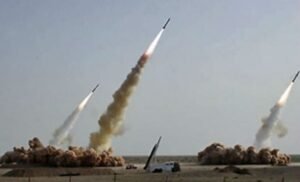India’s Project Vishnu to Develop Hypersonic Missile ET-LDHCM
|
General Studies Paper II: Defence Technology |
Why in News?
Recently, India has taken a major step in advanced defence technology under ‘Project Vishnu’ to develop a hypersonic missile capable of reaching speeds up to 10,000 kmph, strengthening national security and technological self-reliance in modern warfare.

What is the ‘Project Vishnu’?
- About: Project Vishnu is an ambitious defence initiative by the Defence Research and Development Organisation (DRDO) to develop an scramjet-powered, conventional, and nuclear capable long range advanced hypersonic Extended Trajectory–Long Duration Hypersonic Cruise Missile (ET-LDHCM). The missile development began after successful tests of the Hypersonic Technology Demonstrator Vehicle (HSTDV) in 2020, which validated the scramjet propulsion system for sustained hypersonic flight.
- Purpose: The project aims to bolster India’s strategic strike capability with indigenous technology. Its main purpose is to position India among the select nations capable of deploying hypersonic weapons. It reflects a strategic shift toward strike systems that can evade modern air-defence architectures.
- Development Status: Development for Project Vishnu moved into an active phase around 2024, with fabrication of prototypes and ground tests being reported. A publicly noted milestone is a ground test of a scramjet engine lasting about 1,000 seconds. As of mid-2025, DRDO has successfully tested ET-LDHCM flight-test phase from a test range on the eastern coast of India. The full operational deployment is projected over the coming years.
Features of the Hypersonic Missile ‘ET-LDHCM’
- The missile has been designed with a slender aerodynamic body to reduce drag and heat accumulation at hypersonic speeds. It uses a lightweight composite airframe built with heat-resistant materials that can withstand temperatures exceeding 2,000 °C during flight.
- The engine allows the missile to travel at speeds above Mach 8, equivalent to nearly 10,000 km/h. The hypersonic velocity enables the missile to sustain long-range operations while maintaining trajectory stability.
- The missile is powered by an active-cooled scramjet engine that uses atmospheric air for combustion. This technology allows it to sustain high-speed flight for extended durations without depending on heavy onboard oxidisers. The scramjet engine generates continuous thrust, maintaining hypersonic velocity.
- The ET-LDHCM offers a range exceeding 1,500 kilometres, extendable to 2,500 kilometres for the surface-to-surface version. It can carry warheads weighing between 1,000 kg and 2,000 kg, making it suitable for both conventional and nuclear missions. This missile can neutralize heavily fortified targets such as command centres, radar stations, and underground bunkers.
- The missile is designed to fly at low altitudes, reducing its radar signature and improving stealth characteristics. It can perform mid-air manoeuvres and change direction during flight based on real-time geographical data. The guidance system is expected to integrate advanced sensors and navigation software to improve accuracy in all weather conditions.
- It can be launched from land-based launchers, sea-based vessels, or aircraft such as the Sukhoi Su-30 MKI and Dassault Rafale. This flexibility ensures that all three branches of the Indian Armed Forces can operate it efficiently.
- It travels below conventional radar coverage while maintaining high speed. Its surface structure minimizes thermal and electromagnetic signatures, making interception extremely difficult. It can bypass advanced air-defence networks.
Strategic Importance of ‘Project Vishnu’
- National Defence: Project Vishnu plays a crucial role in reinforcing India’s national security by providing a new generation of hypersonic strike capability. Such high velocity drastically will shorten enemy response time and enhance deterrence against potential aggression. The system’s precision and speed will improve the effectiveness of India’s nuclear deterrent.
- Indigenous Innovation: The project highlights India’s growing self-reliance in advanced defence technology. Developed under the Atmanirbhar Bharat mission, Project Vishnu represents a shift from dependence on foreign systems to complete domestic capability. Every stage of the missile is being developed indigenously, setting a foundation for future technologies.
- Regional Balance: Project Vishnu significantly expands India’s strategic reach across its regional sphere of interest. The range will enable India to safeguard its interests across the Indian Ocean Region, South Asia, Pakistan and key maritime routes. The missile’s ability to operate from land, sea, and air platforms will ensure flexible deployment options during both defensive and offensive operations.
- Diplomatic Leverage: Project Vishnu positions India as a technologically advanced defence power on the global stage. The successful testing of the ET-LDHCM in July 2025 demonstrated India’s ability to design such a system. It will create new opportunities for collaboration in research, joint production with friendly nations. It will boost India’s negotiating power in multilateral defence forums.
Hypersonic Missile Race Among Major Powers
- United States: The United States began focused hypersonic development in the early 2000s under the Prompt Global Strike (PGS) programme. The U.S. has developed several systems such as the AGM-183A Air-launched Rapid Response Weapon (ARRW), the Hypersonic Conventional Strike Weapon (HCSW), and the Common Hypersonic Glide Body (C-HGB). The U.S. Navy’s Conventional Prompt Strike (CPS) missile, using the C-HGB, is expected to enter limited service by 2028. The DARPA and Lockheed Martin teams are testing the Hypersonic Air-breathing Weapon Concept (HAWC), designed to use scramjet propulsion for sustained speeds above Mach 5.
- Russia: Russia remains one of the first nations to deploy hypersonic weapons operationally. It tested the Avangard hypersonic glide vehicle in 2018, declaring it combat-ready by 2019. Avangard can travel at speeds of up to Mach 20, carrying either nuclear or conventional payloads. It is mounted on the RS-18 ICBM and later adapted for newer platforms. Russia has also fielded the Kinzhal air-launched ballistic missile, capable of speeds around Mach 10 and a range exceeding 1,500 km. Another major development is the 3M22 Zircon, a ship-launched hypersonic cruise missile reported to achieve Mach 8.
- China: China has made rapid progress in hypersonic research through an integrated national programme led by the People’s Liberation Army Rocket Force (PLARF). Its flagship system, the DF-ZF hypersonic glide vehicle, reportedly travels at Mach 5–10 and can perform mid-air manoeuvres to evade interception. The DF-ZF was first tested in 2014 and entered limited service around 2019. China also tested a new hypersonic system in 2021, which circled the globe before striking a target, surprising many Western analysts. China has built one of the world’s largest hypersonic wind tunnels and invests heavily in scramjet propulsion and heat-resistant composite materials.
|
Also Read: Russia Tested Nuclear-Capable “Poseidon Super Torpedo” |









